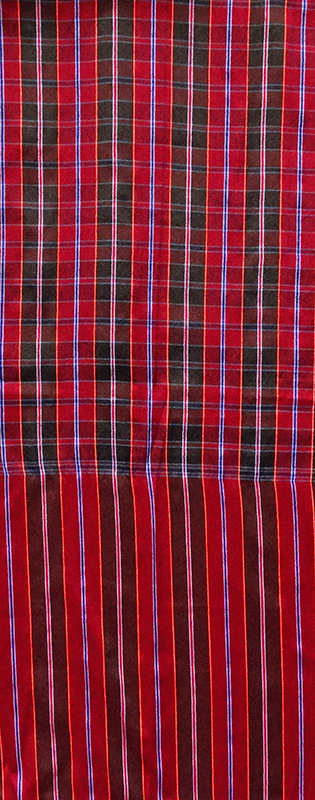

A 'Pha Khao Ma' is a multi-purpose loincloth from the Northeast part of Thailand, a region also known as Isan.
It can be used as scarf, skirt, headband, table cloth or wall decoration. But in Isan it also serves as baby hammock, sitting cloth, decoration for traditional ceremonial tools, storage bag, a sleeping pad, a bathing wear, a towel for drying the body and filling of a broken bike tyre!
This is a factory-made Pha Khao Ma from cotton in Isan.
Traditionally thet are woven by women, but worn by both men and women. It is a very outspoken cultural symbol and usually worn with pride to show the Isan cultural background. It is therefore also associated with molam (folkmusic) culture.
It is a cloth that is very light and dries easy.
About the Isan people
The Isan people (คนอีสาน) or literally Northeastern people are an ethnic Lao group native to Northeastern Thailand with an estimated population of about 22 million.
After the failed Lao Rebellion in 1826 against Siam, many ethnic Lao were forced to move into Isan. Following the separation of Isan from the historical Lao Kingdom, its integration into the Thai nation state and the central government's policy of "Thaification", they have developed a distinct regional identity that differs both from the Laotians of Laos and the Thais of Central Thailand.
Millions of people have migrated from Isan to the Bangkok agglomeration seeking work and they constitute at least one-fourth of the capital's population.
The Isan people faced discrimination for their humble, Lao origins, funny accents, darker features and low-class professions but the extra money earned was sent to support family back home.
Air bases built during the Vietnam War in Isan, and US troops stationed ther,e exposed the Isan people to direct westernisation and adoption of more liberal social attitudes, although there was also resistance against this Western influence.
Isan's culture has much in common with that of neighboring Laos, including cuisine, dress, temple architecture, festivals, and arts.
The traditional dress of Isan is the sarong. Women's sarongs often have an embroidered border at the hem, while men's are in a checkered pattern. Men also wear a pha khao ma, a versatile length of cloth which can be used as a belt, a money and document belt, headwear for protection from the sun, a hammock, or a swimsuit.
Isan is a center for the production of Thai silk. The trade received a major boost in the postwar years, when Jim Thompson popularized Thai silk among Westerners. One of the best-known types of Isan silk is mut-mee, which is tie-dyed to produce geometric patterns on the thread.
The Buddhist temple (or wat) is the major feature of most villages. These temples are used for not only religious ceremonies but also festivals, often with molam music performances, and as assembly halls.
The people of Isan celebrate many traditional festivals, such as the Bun Bang Fai Rocket Festival. This animistic fertility rite, originating in pre-Buddhist times, is celebrated in a number of locations both in Isan and in Laos. Other big festivals include Phi Ta Khon in Dan Sai, the Silk Festival in Khon Kaen, and the That Phanom Festival, which is mainly based on the music and culture of the ethnic Phu Thai people.
The main indigenous music of Isan is molam. It exists in a number of regional variants, plus modern forms. Since the late 1970s it has acquired greater exposure outside the region thanks to the presence of migrant workers in Bangkok. Many molam singers also sing central Thai lukhung music, and have produced the hybrid lukthung Isan form. Another form of folk music, kantrum, is popular with the Khmer minority in the south. Animist Records released a CD with recordings of the most traditional form of kantrum (listen here).
Molam is the most traditional form of entertainment in the region. Usually, a large-sized stage is constructed either in a temple compound or on a sports field. Thousands of people sit on mats on the ground and watch the entertainment. The traditional music and song is accompanied by colorful choreography, executed by a group of up to 50 dancers. The fantastic costumes are changed several times throughout the program, and the transitions are bridged by often-raunchy gags, slapstick comedy, and speeches by local dignitaries. A molam festival is a family affair and the area is surrounded by food and drink stalls.
For a contemporary vision on molam, have a listen to the Animist Records releasing artists of Apichat Pakwan.
- Size: 168 x 75 cm
- Made from cotton